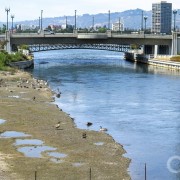Great Lakes Beach Closings Are No Protection From Harmful Pollutants
Updated water testing technology needed to make Great Lakes safer.

Children play in Lake Erie at Luna Pier in water green with algae during an active advisory in 2022 against “whole-body contact” issued by the Monroe County Health Department. Photo © J. Carl Ganter/ Circle of Blue
By Amalia Medina, Circle of Blue – August 13, 2024
A green flag flying on a Great Lakes beach does not necessarily mean it’s safe to swim.
Checking beach monitoring websites like BeachGuard is not a surefire solution either.
These two findings are central to a public health research project, the Great Lakes Microbial Water Quality Assessment, that has set out to measure microbial and chemical threats in Great Lakes waters, and how to reduce the number of illnesses they cause each year. The project, sponsored by the International Joint Commission, released a report last year that said decades-old testing methods are inadequate, and “advances in newer methods are critically needed.” The Commission is bi-national agency that advises the U.S. and Canada on managing water along the border.
The need for such research is urgent. Bacteria draining into recreational waters from overflowing wastewater treatment plants, livestock and poultry farms, and city streets and parking lots results in hundreds of beach closings annually across the five Great Lakes. Phosphorus running off farm fields and from big dairy, hog, and poultry operations causes harmful algal blooms in Lake Erie and other lakes across the region.
Local governments regularly sample water from shorelines to protect public health. But the science and methods for measuring water for harmful microbes and chemicals is too slow, said the report’s authors.
One common testing practice involves collecting a water sample and taking it back to the lab where bacteria grow on a petri plate for about 24 hours. After waiting, lab workers analyze the culture’s E. coli levels, allowing local health departments to determine whether the water is safe for swimming. But that 24-hour lag means the results won’t actually tell you about today’s water, said Tom Edge, a microbiologist who is the Canadian co-chair of the project. “They read the results and they say, ‘OK, the water you were swimming in yesterday was bad, and so for today, we’ll close the beach,’” Edge said. “So we’re always 24 hours behind.”
There are other shortcomings of E. coli tests laid out in the team’s 2023 report, like their inability to identify certain pathogens and viruses. Edge said the tests also can’t distinguish where the E. coli is coming from.
Modern technology would help eliminate these issues, he said. Quantitative polymerase chain reaction (qPCR) tests take only three to four hours to yield results. The tests filter DNA out of the water and use modern genomics and molecular tools to find DNA sequences that could be E. coli or a wide range of other harmful contaminants.
After a few hours, the labs can find out how many DNA copies of the contaminant are in the sample. This number helps health departments determine whether the water is safe for recreational activities.
The results can also clue scientists in to the source of the contaminant, Edge said. Labs can look for DNA sequences of bacteria only found in the gut of a particular species, like humans or seagulls. If there are large numbers of bacteria only found in the human gut, for example, then the contaminant is likely coming from sewage.

Algal blooms caused by runoff pollution cause Lake Erie water to appear green. J. Carl Ganter/ Circle of Blue
Testing issues lead to hazard
The hazards of older testing practices were on display this July at Belle Isle Beach on the Detroit River.
The beach’s water samples are collected on Wednesdays and sent to a private lab. Tom Bissett, the urban district supervisor with the Michigan Department of Natural Resources, said this practice allows the health department to receive results before the weekend, when water recreation is most popular.
But the two-day lag means water collected on Wednesday likely won’t be in the same spot of the river on Friday. And, additional contaminants may enter the water during that time.
“By the time we get those results, that water that we tested on Wednesday is no longer here; it’s much further down river,” Bissett said. “So that’s what makes testing water on a beach so complicated, especially on a river, is that it’s only really a snapshot in that moment of time.”
Last month, the issue became a hazard when the lag time and a communication error resulted in test results being sent out late — after people had swam in the water with unsafe E. coli levels.
Bissett said similar issues occur about once a season. Large storms exacerbate the problem. The remnants of hurricane Beryl last month led to over a dozen contamination-related beach closures in the Great Lakes.

Deploying a second generation environmental sample processor (2G ESP). This device collects and analyzes water samples in near-real time, enhancing scientists’ understanding of the bloom’s toxicity. Credit: NOAA GLERL
Adopting new practices
Bissett said there is a push to improve practices. Not only would quicker tests give a more accurate assessment of when beaches should close, but they would also allow beaches to reopen sooner, he said.
“I think we certainly want to look into the technology, and we want to look into the ability to do something to get more rapid responses,” Bissett said.
Belle Isle recently received Cooperative Science and Monitoring Initiative grant funding from the Michigan Department of Environment, Great Lakes, and Energy (EGLE) to increase its testing frequency.
As recipients of the grant, Bissett said they will also receive test strips that can determine which algal blooms are harmful.
About 30 miles northwest of Belle Isle, Oakland county is also exploring improved testing.
There, modern qPCR tests are used four times per week on 12 inland lakes. For two years, the county has collected samples using old and new testing methods to see if they align.
Oakland’s Environmental Health Unit Public Health Chief, Mark Hansell, said the unit now feels confident in the results. New tests are effective in delivering the same results as the old tests, he said. Only they do it much faster.
Hansell said the county has been able to determine the source of contaminants using qPCR tests. Additionally, their rapid yield enables the county to conduct tests when the lab is closed on weekends.
“It’s an expensive technology, unfortunately, and hopefully that cost will continue to come down,” Hansell said. “But we just had the opportunity to increase the efficiency and effectiveness of our program, and just being able to provide same day results is kind of really the gold standard for us in terms of keeping our swimmers safe.”

Paddle boarders cross Platte Lake, Michigan, where a decades-long campaign reduced algal blooms caused by runoff from a fish hatchery. Photo © J. Carl Ganter/ Circle of Blue
Challenges to new testing
Oakland County’s project is part of a voluntary collaborative effort between local health departments and the Michigan Department of Environment, Great Lakes, and Energy (EGLE).
Shannon Briggs, a water toxicologist at EGLE, said the agency is working to provide local departments with the resources they need to test recreational water. The department primarily finances this through state funding and federal funding from the Environmental Protection Agency.
Briggs, who works in the Water Resources Division of EGLE, was also involved in Bissett’s recently-awarded grant, which uses EPA funding. Briggs said the grant’s funding is on one-year rotations for each of the Great Lakes. Right now, it’s going toward Lake Erie.
But there is only so much funding available, which Briggs said means EGLE has to prioritize Michigan’s most popular and high-risk beaches.
“The more funding we can provide, then the more monitoring and more places can be tested,” Briggs said. “So finances are a limiting factor to the duration, frequency and the amount of beaches tested.”
There is another obstacle to implementing new testing: the IJC is an advisory group and has no regulatory authority. Allison Voglesong Zejnati, an IJC public affairs specialist, said the commission also does not take positions on policy. Instead, the team shares what the standards should be and whether those standards are being met.
That’s why the commission is expanding its operations. The Health Professionals Advisory Board is organizing a steering committee and a technical working group to begin planning for more studies, including a basinwide study.
By demonstrating the benefits of new technology on a larger scale, the experts believe their results lead to advancements that protect beach-goers.
“The ultimate goal of the study is to help, on a more wide scale [and] more systematically, to implement these more modern tools, make it easier, more accessible, and make sure everybody’s kind of on the same page,” Voglesong Zejnati said.
Amalia Medina is a reporting intern at Circle of Blue through the Great Lakes News Collaborative program. She is a senior at Michigan State University pursuing degrees in journalism and comparative cultures & politics.







 © J. Carl Ganter / Circle of Blue
© J. Carl Ganter / Circle of Blue 




Leave a Reply
Want to join the discussion?Feel free to contribute!